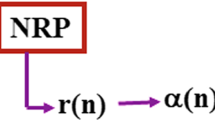Abstract
The process of theory development in physics is a very complex one. The best scientists sometimes proceed on the basis of their physical intuition, ignoring serious conceptual or mathematical objections well known to them at the time.The results soon justify their actions: but the removal of these objections is often not possible for a very long time. Four examples are presented: Newton, Schrödinger, Dirac, Dyson. Some thoughts on this “unreasonableness≓ are offered.
Similar content being viewed by others
References
E. P. Wigner “The unreasonable effectiveness of mathematics in the natural sciences,≓Commun. Pure Appl. Math. XIII, 1–14 (1960).
A. Kantorovich,Scientific Discovery (State University of New York Press, Albany, New York, 1993).
E. McMullin,Newton on Matter and Activity (University of Notre Dame Press, Notre Dame, Indiana, 1978).
Letter from Newton to Bentley, pp. 302–303 in I. B. Cohen,Isaac Newton's Papers and Letters on Natural Philosophy (Harvard University Press, Cambridge, Massachusetts, 1978).
J. A. Wheeler and R. P. Feynman,Rev. Mod. Phys. 17, 157 (1945) and21, 425 (1949).
See, for example, J. Mehra and H. Rechenberg,The Historical Development of Quantum Theory, Vol. 5 (Springer, Berlin, 1987), pp. 419–430; unfortunately, there are several misprints in the equations of this section.
Reference 6, pp. 430–434.
M. Abraham, “Die Grundhypothesen der Elektronentheorie,≓Phys. Z. 5 576–579 (1904).
A. Sommerfeld,Nachr. Akad. Wiss. Göttingen, Math.-Phys. p. 99 (1904), p. 201 (1905).
T. Erber,Fortschr. Phys. 9, 343–392 (1961).
Ph. Pearle, “Classical electron models,≓ inElectromagnetism, D. Teplitz, ed. (Plenum, New York, 1982) pp. 211–295.
P. A. M. Dirac, “Classical theory of radiating electrons,≓Proc. Roy. Soc. London A 167, 148–169 (1938).
F. Rohrlich, “The Art of doing physics in Dirac's way≓, in B. Kursunogluet al., eds.High Energy Physics (Plenum Press, New York, 1985), pp. 17–29.
H. Levine, E. J. Moniz, and D. H. Sharp,Am. J. Phys. 45, 75–78 (1977).
A. D. Yaghjian,Relativistic Dynamics of a Charged Sphere (Springer Berlin 1992).
E. J. Moniz and D. H. Sharp,Phys. Rev. 15, 2850 (1977).
S. S. Schweber,QED and the Men Who Made It (Princeton University Press, Princeton, New Jersey, 1994).
H. A. Bethe,Phys. Rev. 72, 339–341 (1947).
F. J. Dyson,Phys. Rev. 75, 486–502, 1736–1755 (1949).
Author information
Authors and Affiliations
Additional information
This paper is dedicated to Larry Horwitz, an old friend and colleague, and an excellent mathematical physicist. May his sixty-fifth birthday be followed by many more.
Rights and permissions
About this article
Cite this article
Rohrlich, F. The unreasonable effectiveness of physical intuition: Success while ignoring objections. Found Phys 26, 1617–1626 (1996). https://doi.org/10.1007/BF02282125
Received:
Issue Date:
DOI: https://doi.org/10.1007/BF02282125




